Quantitative Research Methods for Social Scientists
VerifiedAdded on 2023/06/12
|7
|1641
|258
AI Summary
This article discusses the basics of quantitative research methods for social scientists, including the four levels of measurement, measures of central tendency and dispersion, descriptive and inferential statistics, hypothesis and null hypothesis, independent and dependent variables, and interpretation of SPSS results. It also provides examples and references to support the explanations.
Contribute Materials
Your contribution can guide someone’s learning journey. Share your
documents today.
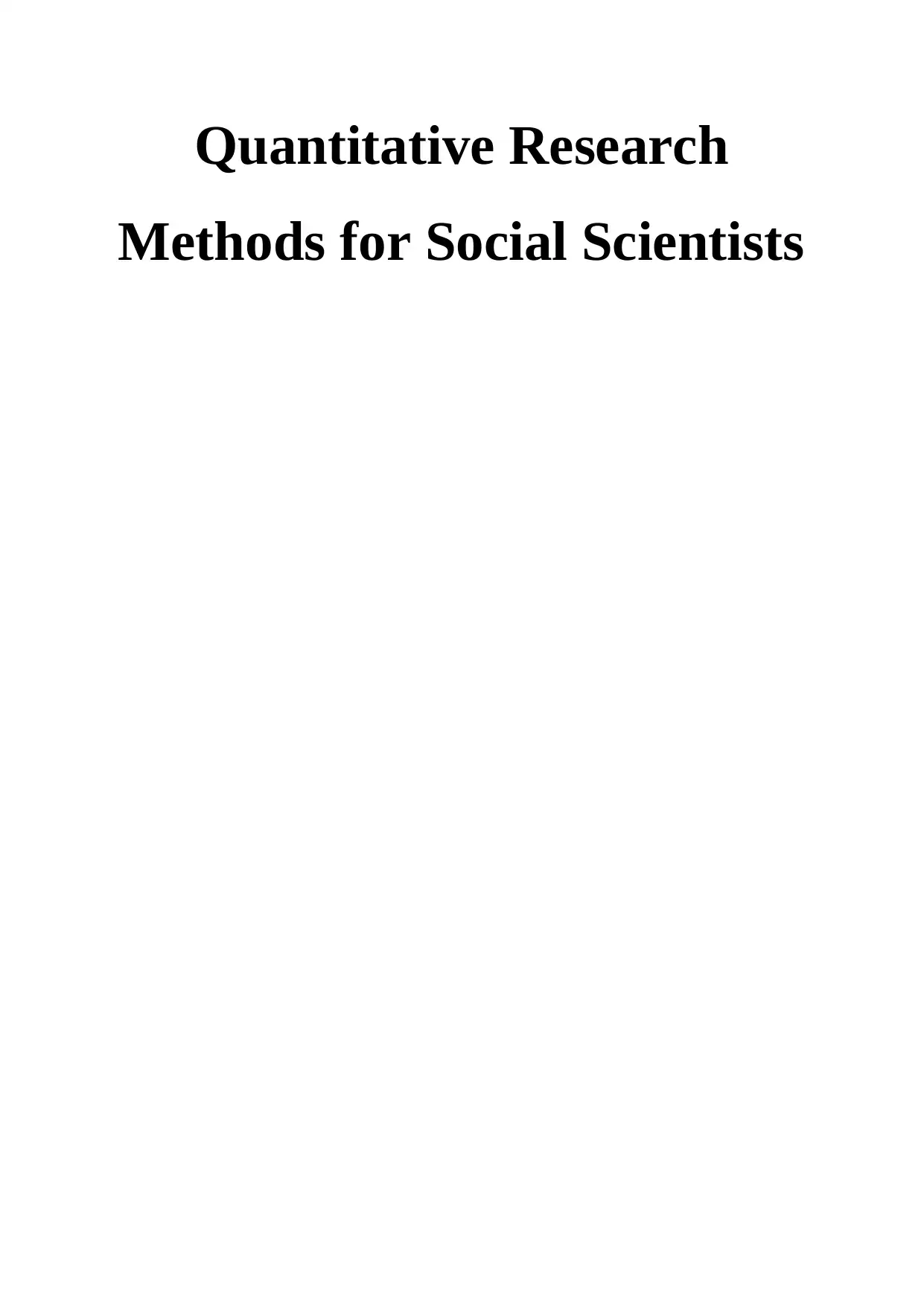
Quantitative Research
Methods for Social Scientists
Methods for Social Scientists
Secure Best Marks with AI Grader
Need help grading? Try our AI Grader for instant feedback on your assignments.
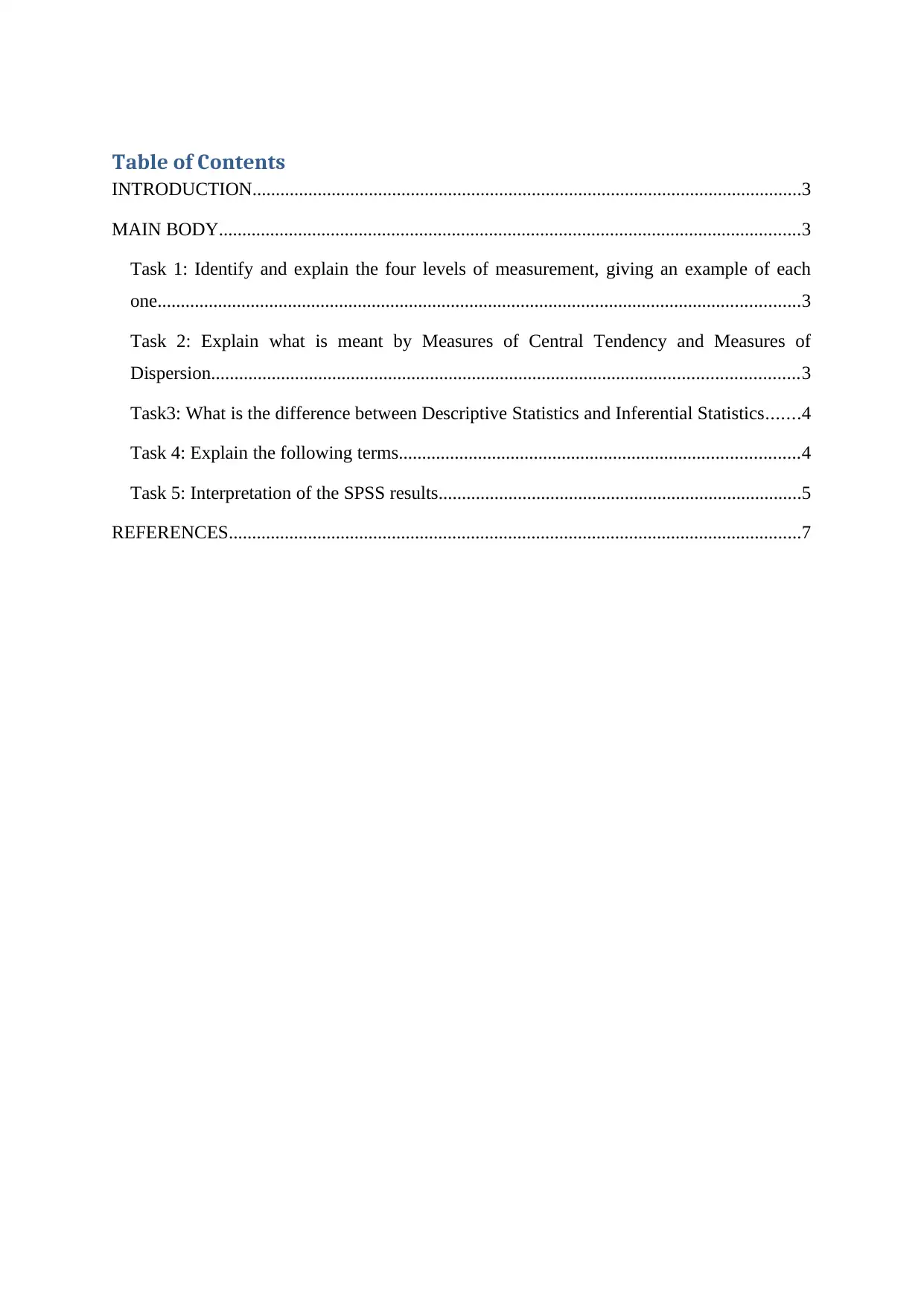
Table of Contents
INTRODUCTION......................................................................................................................3
MAIN BODY.............................................................................................................................3
Task 1: Identify and explain the four levels of measurement, giving an example of each
one..........................................................................................................................................3
Task 2: Explain what is meant by Measures of Central Tendency and Measures of
Dispersion..............................................................................................................................3
Task3: What is the difference between Descriptive Statistics and Inferential Statistics.......4
Task 4: Explain the following terms......................................................................................4
Task 5: Interpretation of the SPSS results..............................................................................5
REFERENCES...........................................................................................................................7
INTRODUCTION......................................................................................................................3
MAIN BODY.............................................................................................................................3
Task 1: Identify and explain the four levels of measurement, giving an example of each
one..........................................................................................................................................3
Task 2: Explain what is meant by Measures of Central Tendency and Measures of
Dispersion..............................................................................................................................3
Task3: What is the difference between Descriptive Statistics and Inferential Statistics.......4
Task 4: Explain the following terms......................................................................................4
Task 5: Interpretation of the SPSS results..............................................................................5
REFERENCES...........................................................................................................................7
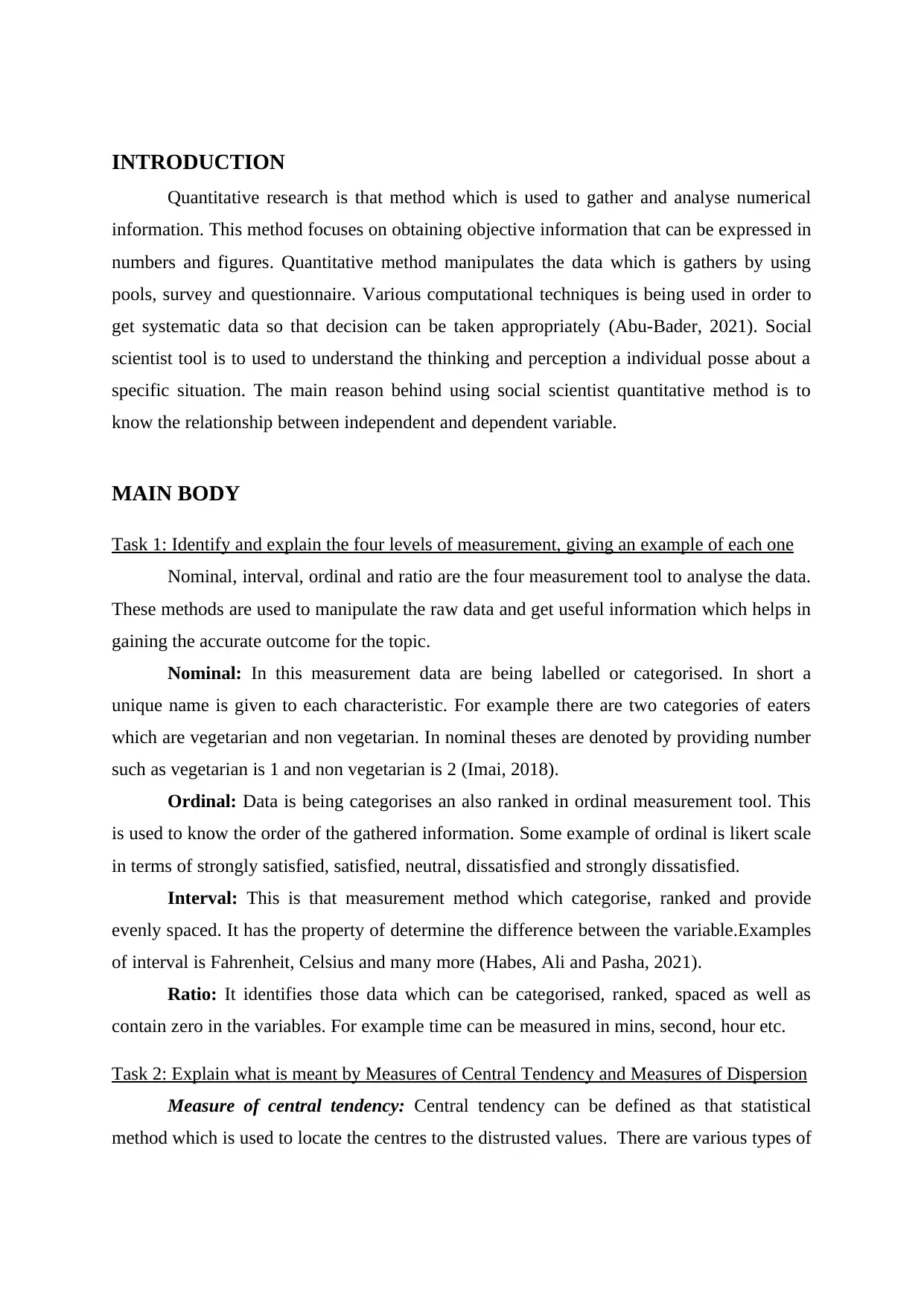
INTRODUCTION
Quantitative research is that method which is used to gather and analyse numerical
information. This method focuses on obtaining objective information that can be expressed in
numbers and figures. Quantitative method manipulates the data which is gathers by using
pools, survey and questionnaire. Various computational techniques is being used in order to
get systematic data so that decision can be taken appropriately (Abu-Bader, 2021). Social
scientist tool is to used to understand the thinking and perception a individual posse about a
specific situation. The main reason behind using social scientist quantitative method is to
know the relationship between independent and dependent variable.
MAIN BODY
Task 1: Identify and explain the four levels of measurement, giving an example of each one
Nominal, interval, ordinal and ratio are the four measurement tool to analyse the data.
These methods are used to manipulate the raw data and get useful information which helps in
gaining the accurate outcome for the topic.
Nominal: In this measurement data are being labelled or categorised. In short a
unique name is given to each characteristic. For example there are two categories of eaters
which are vegetarian and non vegetarian. In nominal theses are denoted by providing number
such as vegetarian is 1 and non vegetarian is 2 (Imai, 2018).
Ordinal: Data is being categorises an also ranked in ordinal measurement tool. This
is used to know the order of the gathered information. Some example of ordinal is likert scale
in terms of strongly satisfied, satisfied, neutral, dissatisfied and strongly dissatisfied.
Interval: This is that measurement method which categorise, ranked and provide
evenly spaced. It has the property of determine the difference between the variable.Examples
of interval is Fahrenheit, Celsius and many more (Habes, Ali and Pasha, 2021).
Ratio: It identifies those data which can be categorised, ranked, spaced as well as
contain zero in the variables. For example time can be measured in mins, second, hour etc.
Task 2: Explain what is meant by Measures of Central Tendency and Measures of Dispersion
Measure of central tendency: Central tendency can be defined as that statistical
method which is used to locate the centres to the distrusted values. There are various types of
Quantitative research is that method which is used to gather and analyse numerical
information. This method focuses on obtaining objective information that can be expressed in
numbers and figures. Quantitative method manipulates the data which is gathers by using
pools, survey and questionnaire. Various computational techniques is being used in order to
get systematic data so that decision can be taken appropriately (Abu-Bader, 2021). Social
scientist tool is to used to understand the thinking and perception a individual posse about a
specific situation. The main reason behind using social scientist quantitative method is to
know the relationship between independent and dependent variable.
MAIN BODY
Task 1: Identify and explain the four levels of measurement, giving an example of each one
Nominal, interval, ordinal and ratio are the four measurement tool to analyse the data.
These methods are used to manipulate the raw data and get useful information which helps in
gaining the accurate outcome for the topic.
Nominal: In this measurement data are being labelled or categorised. In short a
unique name is given to each characteristic. For example there are two categories of eaters
which are vegetarian and non vegetarian. In nominal theses are denoted by providing number
such as vegetarian is 1 and non vegetarian is 2 (Imai, 2018).
Ordinal: Data is being categorises an also ranked in ordinal measurement tool. This
is used to know the order of the gathered information. Some example of ordinal is likert scale
in terms of strongly satisfied, satisfied, neutral, dissatisfied and strongly dissatisfied.
Interval: This is that measurement method which categorise, ranked and provide
evenly spaced. It has the property of determine the difference between the variable.Examples
of interval is Fahrenheit, Celsius and many more (Habes, Ali and Pasha, 2021).
Ratio: It identifies those data which can be categorised, ranked, spaced as well as
contain zero in the variables. For example time can be measured in mins, second, hour etc.
Task 2: Explain what is meant by Measures of Central Tendency and Measures of Dispersion
Measure of central tendency: Central tendency can be defined as that statistical
method which is used to locate the centres to the distrusted values. There are various types of
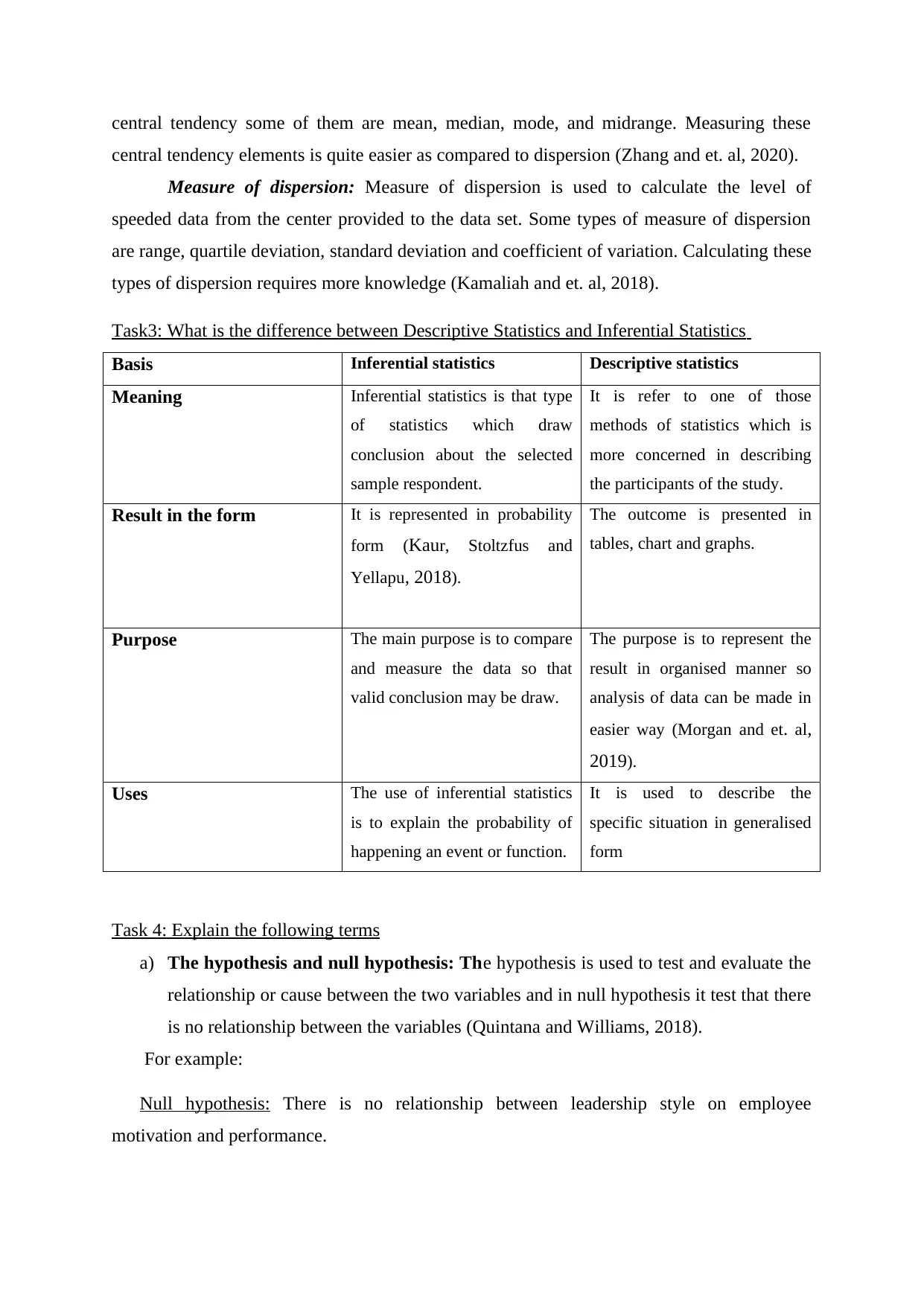
central tendency some of them are mean, median, mode, and midrange. Measuring these
central tendency elements is quite easier as compared to dispersion (Zhang and et. al, 2020).
Measure of dispersion: Measure of dispersion is used to calculate the level of
speeded data from the center provided to the data set. Some types of measure of dispersion
are range, quartile deviation, standard deviation and coefficient of variation. Calculating these
types of dispersion requires more knowledge (Kamaliah and et. al, 2018).
Task3: What is the difference between Descriptive Statistics and Inferential Statistics
Basis Inferential statistics Descriptive statistics
Meaning Inferential statistics is that type
of statistics which draw
conclusion about the selected
sample respondent.
It is refer to one of those
methods of statistics which is
more concerned in describing
the participants of the study.
Result in the form It is represented in probability
form (Kaur, Stoltzfus and
Yellapu, 2018).
The outcome is presented in
tables, chart and graphs.
Purpose The main purpose is to compare
and measure the data so that
valid conclusion may be draw.
The purpose is to represent the
result in organised manner so
analysis of data can be made in
easier way (Morgan and et. al,
2019).
Uses The use of inferential statistics
is to explain the probability of
happening an event or function.
It is used to describe the
specific situation in generalised
form
Task 4: Explain the following terms
a) The hypothesis and null hypothesis: The hypothesis is used to test and evaluate the
relationship or cause between the two variables and in null hypothesis it test that there
is no relationship between the variables (Quintana and Williams, 2018).
For example:
Null hypothesis: There is no relationship between leadership style on employee
motivation and performance.
central tendency elements is quite easier as compared to dispersion (Zhang and et. al, 2020).
Measure of dispersion: Measure of dispersion is used to calculate the level of
speeded data from the center provided to the data set. Some types of measure of dispersion
are range, quartile deviation, standard deviation and coefficient of variation. Calculating these
types of dispersion requires more knowledge (Kamaliah and et. al, 2018).
Task3: What is the difference between Descriptive Statistics and Inferential Statistics
Basis Inferential statistics Descriptive statistics
Meaning Inferential statistics is that type
of statistics which draw
conclusion about the selected
sample respondent.
It is refer to one of those
methods of statistics which is
more concerned in describing
the participants of the study.
Result in the form It is represented in probability
form (Kaur, Stoltzfus and
Yellapu, 2018).
The outcome is presented in
tables, chart and graphs.
Purpose The main purpose is to compare
and measure the data so that
valid conclusion may be draw.
The purpose is to represent the
result in organised manner so
analysis of data can be made in
easier way (Morgan and et. al,
2019).
Uses The use of inferential statistics
is to explain the probability of
happening an event or function.
It is used to describe the
specific situation in generalised
form
Task 4: Explain the following terms
a) The hypothesis and null hypothesis: The hypothesis is used to test and evaluate the
relationship or cause between the two variables and in null hypothesis it test that there
is no relationship between the variables (Quintana and Williams, 2018).
For example:
Null hypothesis: There is no relationship between leadership style on employee
motivation and performance.
Secure Best Marks with AI Grader
Need help grading? Try our AI Grader for instant feedback on your assignments.
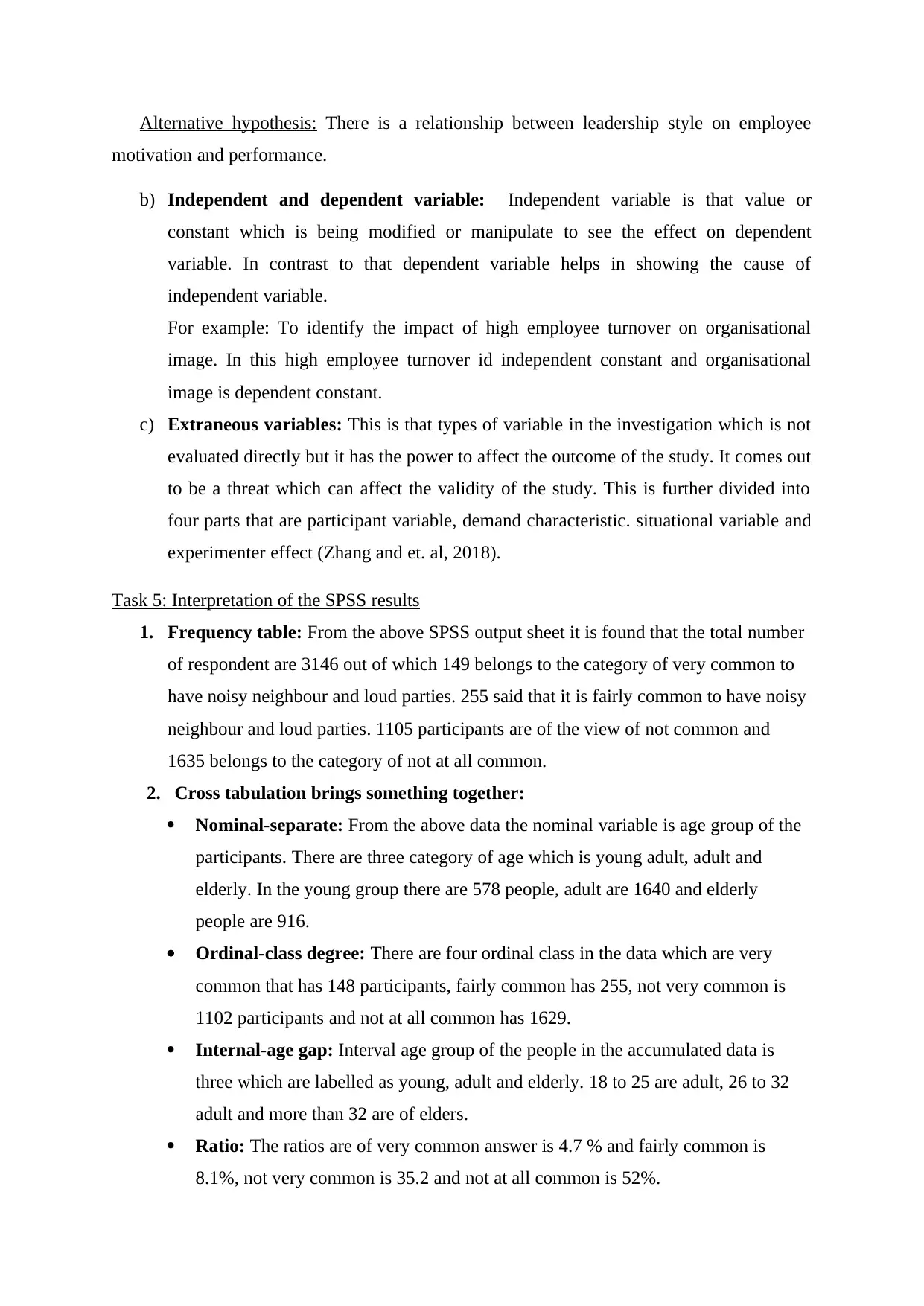
Alternative hypothesis: There is a relationship between leadership style on employee
motivation and performance.
b) Independent and dependent variable: Independent variable is that value or
constant which is being modified or manipulate to see the effect on dependent
variable. In contrast to that dependent variable helps in showing the cause of
independent variable.
For example: To identify the impact of high employee turnover on organisational
image. In this high employee turnover id independent constant and organisational
image is dependent constant.
c) Extraneous variables: This is that types of variable in the investigation which is not
evaluated directly but it has the power to affect the outcome of the study. It comes out
to be a threat which can affect the validity of the study. This is further divided into
four parts that are participant variable, demand characteristic. situational variable and
experimenter effect (Zhang and et. al, 2018).
Task 5: Interpretation of the SPSS results
1. Frequency table: From the above SPSS output sheet it is found that the total number
of respondent are 3146 out of which 149 belongs to the category of very common to
have noisy neighbour and loud parties. 255 said that it is fairly common to have noisy
neighbour and loud parties. 1105 participants are of the view of not common and
1635 belongs to the category of not at all common.
2. Cross tabulation brings something together:
Nominal-separate: From the above data the nominal variable is age group of the
participants. There are three category of age which is young adult, adult and
elderly. In the young group there are 578 people, adult are 1640 and elderly
people are 916.
Ordinal-class degree: There are four ordinal class in the data which are very
common that has 148 participants, fairly common has 255, not very common is
1102 participants and not at all common has 1629.
Internal-age gap: Interval age group of the people in the accumulated data is
three which are labelled as young, adult and elderly. 18 to 25 are adult, 26 to 32
adult and more than 32 are of elders.
Ratio: The ratios are of very common answer is 4.7 % and fairly common is
8.1%, not very common is 35.2 and not at all common is 52%.
motivation and performance.
b) Independent and dependent variable: Independent variable is that value or
constant which is being modified or manipulate to see the effect on dependent
variable. In contrast to that dependent variable helps in showing the cause of
independent variable.
For example: To identify the impact of high employee turnover on organisational
image. In this high employee turnover id independent constant and organisational
image is dependent constant.
c) Extraneous variables: This is that types of variable in the investigation which is not
evaluated directly but it has the power to affect the outcome of the study. It comes out
to be a threat which can affect the validity of the study. This is further divided into
four parts that are participant variable, demand characteristic. situational variable and
experimenter effect (Zhang and et. al, 2018).
Task 5: Interpretation of the SPSS results
1. Frequency table: From the above SPSS output sheet it is found that the total number
of respondent are 3146 out of which 149 belongs to the category of very common to
have noisy neighbour and loud parties. 255 said that it is fairly common to have noisy
neighbour and loud parties. 1105 participants are of the view of not common and
1635 belongs to the category of not at all common.
2. Cross tabulation brings something together:
Nominal-separate: From the above data the nominal variable is age group of the
participants. There are three category of age which is young adult, adult and
elderly. In the young group there are 578 people, adult are 1640 and elderly
people are 916.
Ordinal-class degree: There are four ordinal class in the data which are very
common that has 148 participants, fairly common has 255, not very common is
1102 participants and not at all common has 1629.
Internal-age gap: Interval age group of the people in the accumulated data is
three which are labelled as young, adult and elderly. 18 to 25 are adult, 26 to 32
adult and more than 32 are of elders.
Ratio: The ratios are of very common answer is 4.7 % and fairly common is
8.1%, not very common is 35.2 and not at all common is 52%.

3. Chi-square result: With the above accumulated piece of information it is discussed
that there is no relationship between the age group of people and loud parties. The
significance value is 0.05 which means that null hypothesis will be accepted.
4. Phi/Cramer’s: In the above data sheet it is analysed that the two variables age
group and loud parties are not associated with each other and there is low strength
between the two.
that there is no relationship between the age group of people and loud parties. The
significance value is 0.05 which means that null hypothesis will be accepted.
4. Phi/Cramer’s: In the above data sheet it is analysed that the two variables age
group and loud parties are not associated with each other and there is low strength
between the two.
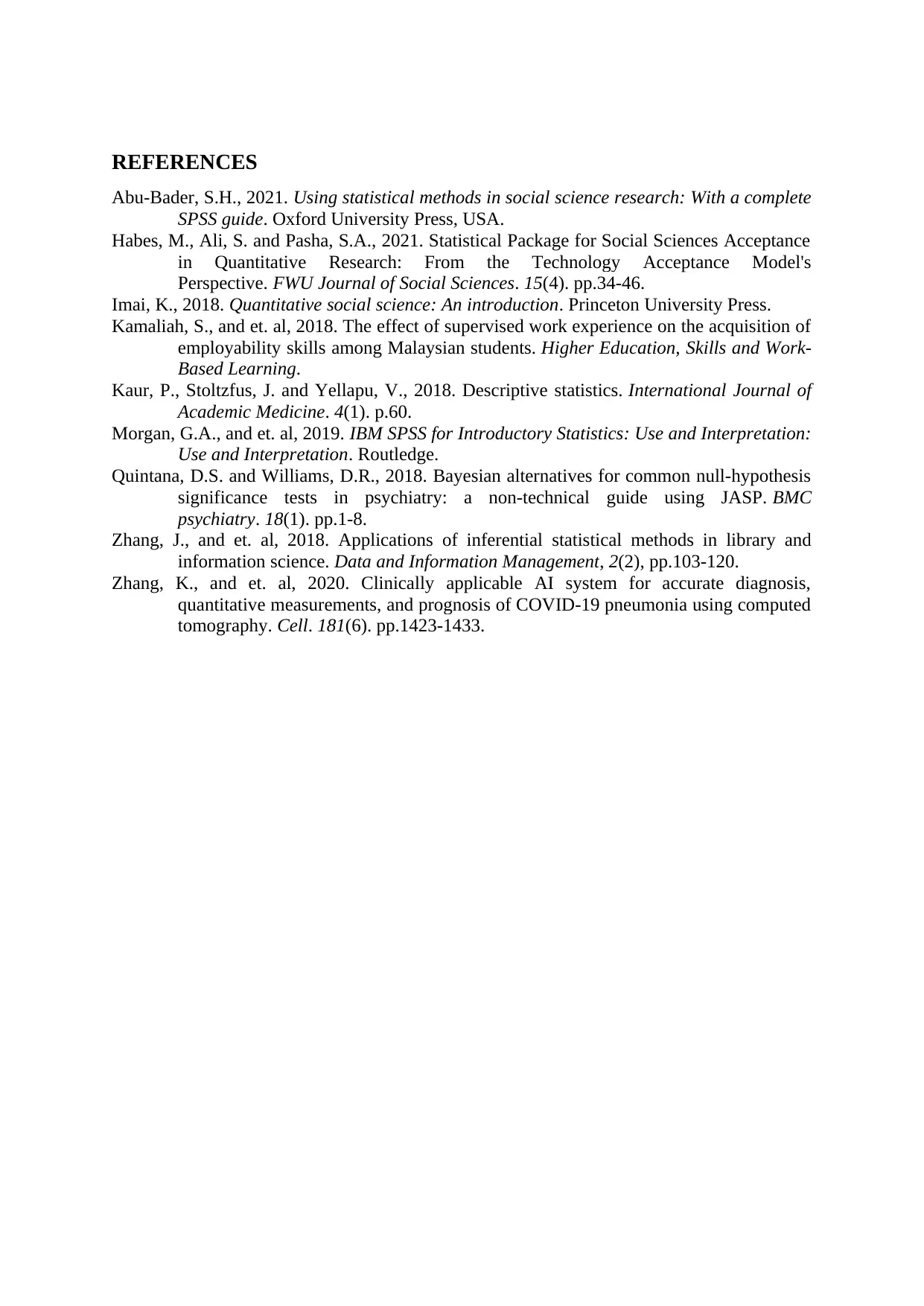
REFERENCES
Abu-Bader, S.H., 2021. Using statistical methods in social science research: With a complete
SPSS guide. Oxford University Press, USA.
Habes, M., Ali, S. and Pasha, S.A., 2021. Statistical Package for Social Sciences Acceptance
in Quantitative Research: From the Technology Acceptance Model's
Perspective. FWU Journal of Social Sciences. 15(4). pp.34-46.
Imai, K., 2018. Quantitative social science: An introduction. Princeton University Press.
Kamaliah, S., and et. al, 2018. The effect of supervised work experience on the acquisition of
employability skills among Malaysian students. Higher Education, Skills and Work-
Based Learning.
Kaur, P., Stoltzfus, J. and Yellapu, V., 2018. Descriptive statistics. International Journal of
Academic Medicine. 4(1). p.60.
Morgan, G.A., and et. al, 2019. IBM SPSS for Introductory Statistics: Use and Interpretation:
Use and Interpretation. Routledge.
Quintana, D.S. and Williams, D.R., 2018. Bayesian alternatives for common null-hypothesis
significance tests in psychiatry: a non-technical guide using JASP. BMC
psychiatry. 18(1). pp.1-8.
Zhang, J., and et. al, 2018. Applications of inferential statistical methods in library and
information science. Data and Information Management, 2(2), pp.103-120.
Zhang, K., and et. al, 2020. Clinically applicable AI system for accurate diagnosis,
quantitative measurements, and prognosis of COVID-19 pneumonia using computed
tomography. Cell. 181(6). pp.1423-1433.
Abu-Bader, S.H., 2021. Using statistical methods in social science research: With a complete
SPSS guide. Oxford University Press, USA.
Habes, M., Ali, S. and Pasha, S.A., 2021. Statistical Package for Social Sciences Acceptance
in Quantitative Research: From the Technology Acceptance Model's
Perspective. FWU Journal of Social Sciences. 15(4). pp.34-46.
Imai, K., 2018. Quantitative social science: An introduction. Princeton University Press.
Kamaliah, S., and et. al, 2018. The effect of supervised work experience on the acquisition of
employability skills among Malaysian students. Higher Education, Skills and Work-
Based Learning.
Kaur, P., Stoltzfus, J. and Yellapu, V., 2018. Descriptive statistics. International Journal of
Academic Medicine. 4(1). p.60.
Morgan, G.A., and et. al, 2019. IBM SPSS for Introductory Statistics: Use and Interpretation:
Use and Interpretation. Routledge.
Quintana, D.S. and Williams, D.R., 2018. Bayesian alternatives for common null-hypothesis
significance tests in psychiatry: a non-technical guide using JASP. BMC
psychiatry. 18(1). pp.1-8.
Zhang, J., and et. al, 2018. Applications of inferential statistical methods in library and
information science. Data and Information Management, 2(2), pp.103-120.
Zhang, K., and et. al, 2020. Clinically applicable AI system for accurate diagnosis,
quantitative measurements, and prognosis of COVID-19 pneumonia using computed
tomography. Cell. 181(6). pp.1423-1433.
1 out of 7
Related Documents
Your All-in-One AI-Powered Toolkit for Academic Success.
+13062052269
info@desklib.com
Available 24*7 on WhatsApp / Email
![[object Object]](/_next/static/media/star-bottom.7253800d.svg)
Unlock your academic potential
© 2024 | Zucol Services PVT LTD | All rights reserved.

